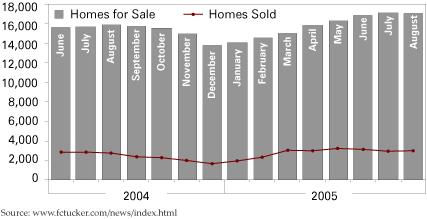Indianapolis
Associate Clinical Professor of Business Economics, Kelley School of Business, Indiana University, Indianapolis
The data and forecasts in this article refer to the entire Indianapolis metro, including Boone, Hamilton, Hancock, Hendricks, Johnson, Madison, Marion, Morgan, and Shelby counties. Unless otherwise stated, all data is from the U.S. Census Bureau (www.census.gov) or STATS Indiana (www.stats.indiana.edu). STATS Indiana is maintained by the Indiana Business Research Center at the Indiana University Kelley School of Business.
Income
Income for households in the Indianapolis metro is shrinking. According to the U.S. Census Bureau’s American Community Survey, real median family income in Indianapolis fell $2,240 and only $491 nationally between 2002 and 2003. Between the first quarters of 2004 and 2005, real weekly wages fell 2.7 percent. Income shrinkage is caused by two things. First, there is no dynamic growth in the local economy. Second, high-paying professional jobs are disappearing as Indianapolis-based corporate headquarters are closed through merger and bankruptcy (such as Great Lakes Chemical Company, Galyans, and American Trans Air).
Employment
Between August 2004 and August 2005, the local unemployment rate increased from 4.6 percent to 4.7 percent, while the national unemployment rate fell from 5.4 percent to 4.9 percent. More individuals have entered the labor force in Indianapolis, but their wait for a new job has not shortened like it has in the rest of the United States. Between 2004 and 2005, the highest rates of local job growth were 9.7 percent in administrative services, 6.0 percent in transportation and warehousing, and 4.1 percent in professional and scientific services. Finance and insurance jobs shrank by 2.8 percent and growth in government jobs was flat. All other sectors of the local economy saw job growth of 3 percent or less.
Real Estate
Between April 1, 2000, and July 1, 2003, the U.S. Census Bureau estimates that the population of the Indianapolis metropolitan area increased by 70,273 individuals (4.6 percent). From the beginning of 2001 to the end of 2003, enough building permits were approved to house an estimated 211,507 individuals in new structures. This trend suggests that housing capacity is expanding at three times the rate of population growth. Employment in construction remained steady at 45,000 jobs between the first quarters of 2004 and 2005, but the average wage fell from $788 to $770 per week.
Figure 1 shows home sales in the past year. A situation of excess supply explains why the real value of residential real estate in the metro has fallen 1.5 percent over the last four years. Only 40 percent of the new housing being constructed is in Marion County. Between April 1, 2000, and July 1, 2003, the U.S. Census Bureau estimates that the population of Marion County grew by 3,407 while the populations of Hendricks and Hamilton counties grew by 14,787 and 38,124, respectively. These numbers underscore massive migration out of Marion County townships and into suburban communities. In an environment of excess housing supply, this type of population movement negatively impacts the real wealth of both urban and suburban residents. Real estate values in Marion County fall because there is no increase in population. Real estate values in suburban communities do not appreciate because the construction of new homes floods local markets and keeps prices low.
Figure 1
Metro Homes Sold Compared to Homes for Sale, 2004 to 2005

Forecast
The current Indianapolis economy is anemic and will continue to fall behind the nation in 2006. Permanently higher energy prices, cheaper labor in foreign countries, and a possible General Motors bankruptcy place worrisome pressure on a local economy that remains too dependent on non-vibrant industries. Job growth will occur, but at an unimpressive rate and not in high-paying occupations. Real household income is expected to shrink locally by 1 percent in 2006. Real estate wealth will also shrink as developers continue to build in over-supplied communities and deflate the price of homes in neighborhoods that are already established. Growth among local life science and technology enterprises will be notable, but their small presence in the Indianapolis economy will not reverse a more general malaise. If the current trend continues, Indianapolis risks becoming an economic satellite of cities that demonstrate a more energetic and pioneering approach to economic development.
Notes
- This calculation assumes 2.6 individuals per household, as estimated by the U.S. Census Bureau.
- Calculation based on data from “Bringing Down the House,” Indianapolis Star 16 October 2005.
Also in this Issue…



